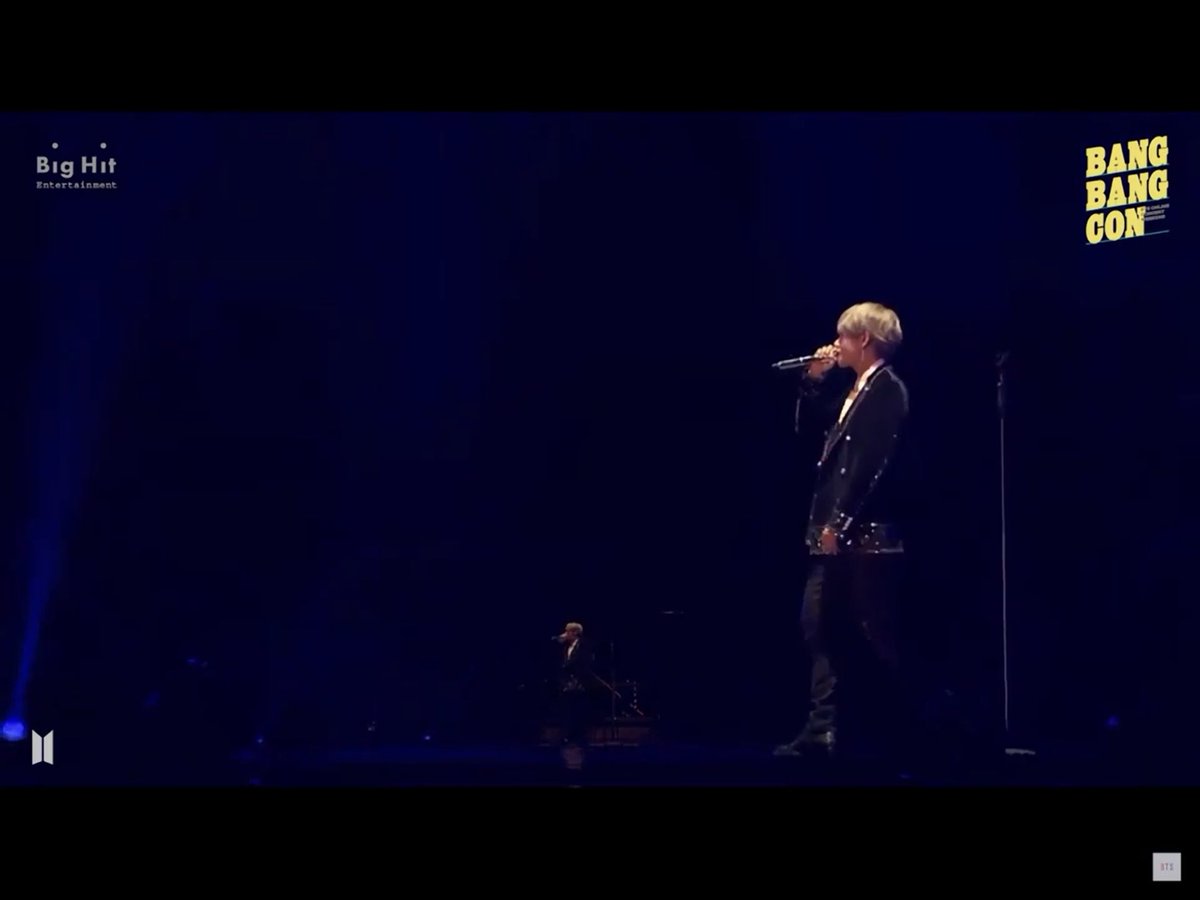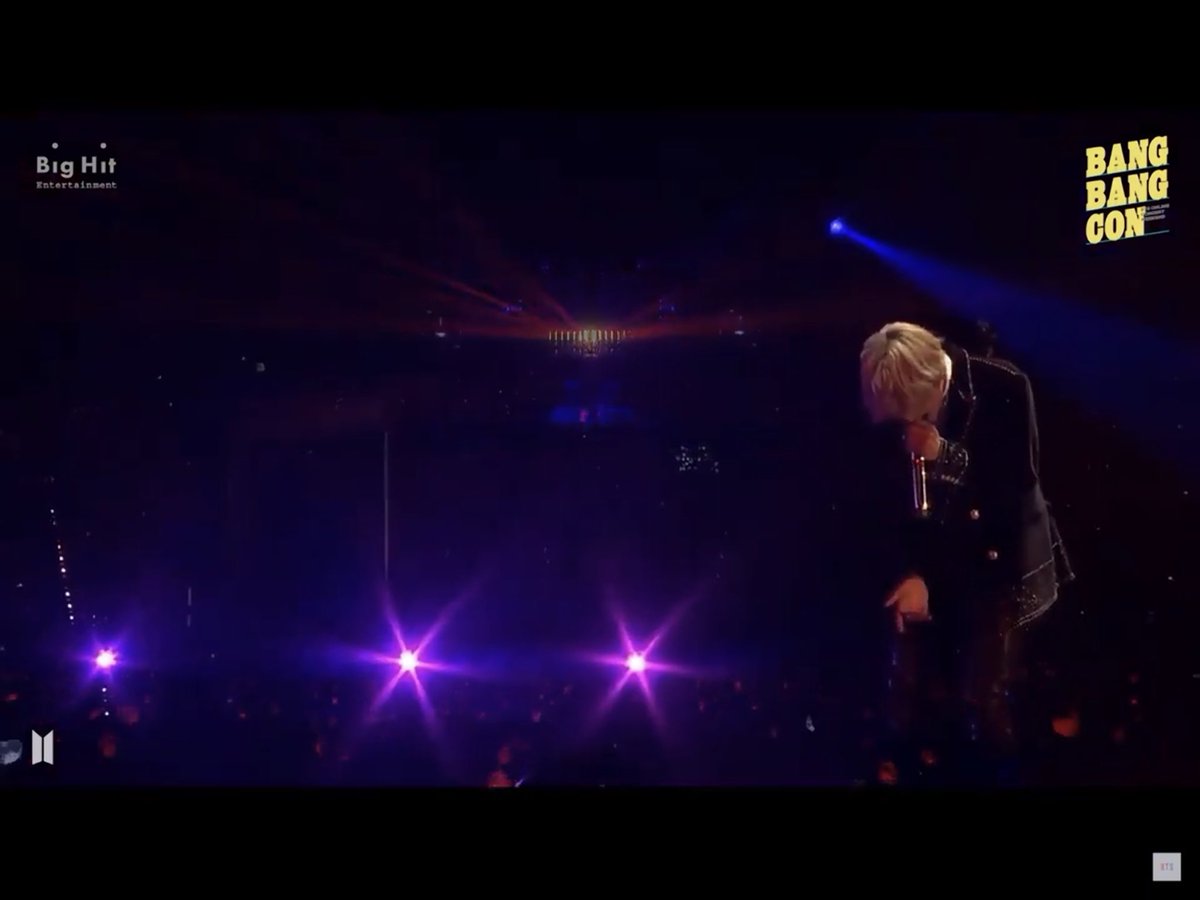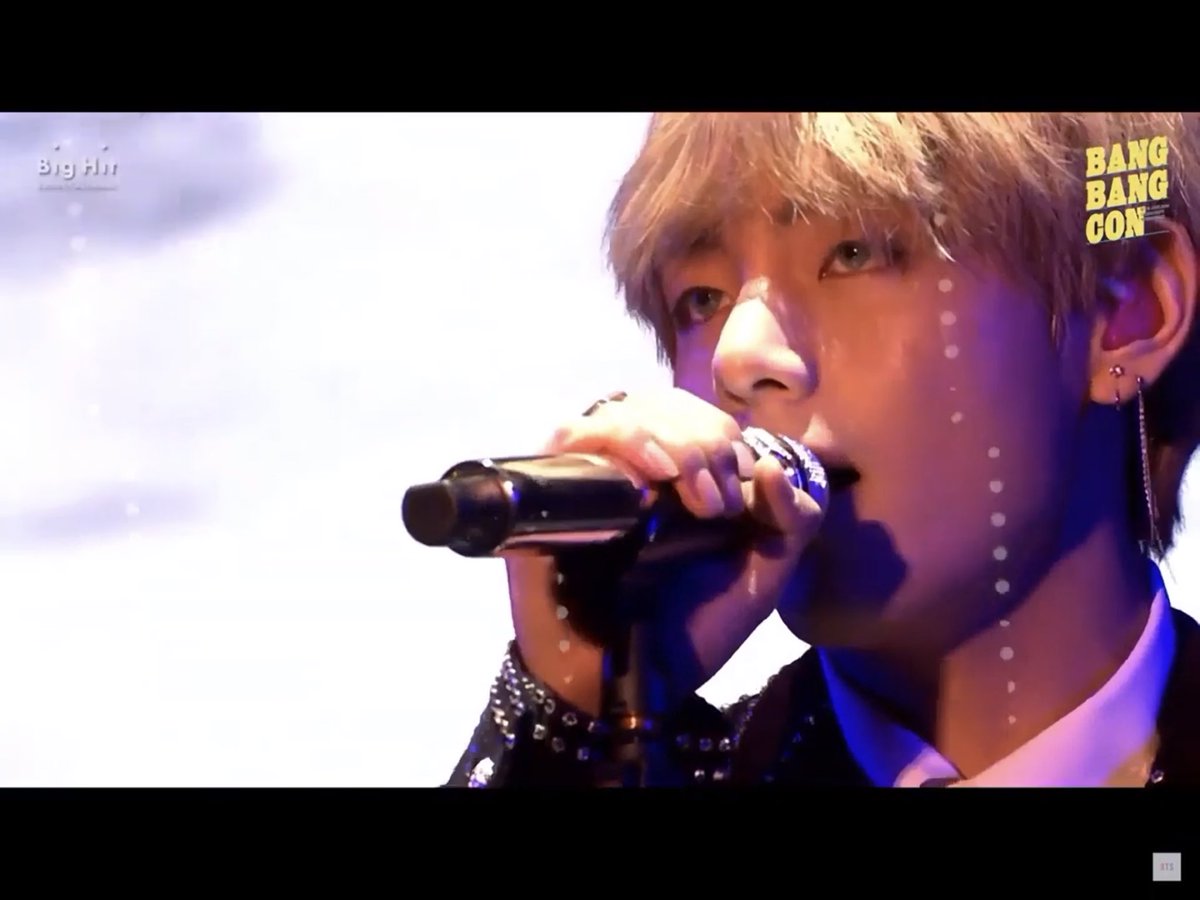Retrospective: Taehyung’s Live Vocals in 「Stigma」
If there is a song that cemented Taehyung’s professional skills as a vocalist, this feat goes to none other than his very own first solo under the BTS name, his self-penned “Stigma”.
If there is a song that cemented Taehyung’s professional skills as a vocalist, this feat goes to none other than his very own first solo under the BTS name, his self-penned “Stigma”.
Before we go on, we are aware that this song also happens to be his most analyzed yet, and we don’t know if this thread will provide any more insight, but we want our own take of the his vocal performance that truly bewildered everyone.
Let’s get to it right now — there’s an intimate vibe to this song with the way Tae positions his microphone to his mouth, creating that airy yet dark overtone. Throughout the song, he employs a calm, reserved demeanor. We’ve encountered people saying that he looks shy,
but we believe that apart from showcasing his relaxed and effortless stature as he sings, he is also donning the character in the song — the one confessor of a secret. But let’s save the conversation of Stigma’s piercing lyrics for another day and move forward.
The first verse starts with his chest voice and there’s a staccato-like singing going on. In contrast to legato when notation is continuous and fluid, staccato notes are sung in an obviously detached, broken manner. Hear that vibrato and resonance? It’s so rich and full.
Not that this is any new information, but let’s still put it out here that this song is made up of Tae’s falsettos and a testament to how extraordinary he is for accessing this tricky technique and nailing it.
Tricky, because it’s really not as easy as it sounds, and more often than not will sound bad and forced. Singing in falsetto means to sing without the support of your vocal chords (the vocal folds are not drawn together, therefore air can freely pass) +
as the sound being produced comes from the vibration of vocal ligaments. The main vocal membranes are relaxed, with vocal ligaments also stretched tighter.
Here’s a warm-up: you can here him move from chest to falsetto (oh so very quickly), then dipping back to chest very smoothly. It’s found in the syllable “geuTTAEN”. This is some incredible sense of control (in which how little we would usually have with the falsetto voice)
and this smooth slip can only be achieved with thorough and constant practice. In fact, he does this quite a few times in the song — smoothly transitioning from falsetto to chest.
Tae adds more falsetto singing in this refrain paired with really resonant chest, full voice. “Now cry”, he sings, and he actually does during this part as he uses his cry mode. This is just so witty and detailed of him, and as with the lyrics, Tae will keep “crying”. +
What do we mean that he will keep crying? Well, he continues to do so in the chorus, the 2nd verse and the 2nd chorus. Again this is just such a nice detail of storytelling through his voice. It’s also a helpful technique for high notes, easing tension and adds more emotionality.
We discussed this technique too in Lights live: https://twitter.com/taefolio/status/1242985963460022275?s=21">https://twitter.com/taefolio/...
The beloved chorus is all about Taehyung’s endurance and trained ear. We already know that he sings this mostly in his falsetto with impeccable stability, but also let’s give some applause to his trained ear for pulling off this syncopated technique.
What do we mean by syncopated? The accents of Tae’s vocals here are syncopated, meaning he isn’t accenting by following the time signature of the song. There are parts in which he accents on the weaker beats of the rhythm instead of the accented notes.
To sing in syncopated is to have a trained ear and good sense of rhythm — and Taehyung shows it. Syncopated singing is also a common technique in jazz and is a huge element to the genre. Remember, the voice is just as much of an instrument too.
Ref: https://newyorkjazzworkshop.com/what-are-the-elements-of-jazz/">https://newyorkjazzworkshop.com/what-are-...
Ref: https://newyorkjazzworkshop.com/what-are-the-elements-of-jazz/">https://newyorkjazzworkshop.com/what-are-...
Check out this rhythm training too as it also teaches more about syncopation. Basically, this is what happens in Stigma’s chorus with Tae’s vocals and the beat. https://youtu.be/RuvA4b_2pk0 ">https://youtu.be/RuvA4b_2p...
All right moving on to the 2nd verse, we did mention a few tweets ago that Tae will keep “crying”. a.k.a. Keep his cry mode on and there’s a reason for that. The 2nd verse carries over the emotional build-up from the chorus as Tae continues to sing in bet. head voice and falsetto
We’d expect for the second verse to slope down from the chorus and repeat the pitch pattern in the first verse, but this does not happen in Stigma. See, this is what makes the line “now cry” so significant and detailed as it employs the technique itself in its storytelling.
On the bridge, we are greeted with a brief respite from Taehyung’s crying as he cushions us in his chest voice and head dominant-mixed. Of course, this is just to further build-up the anticipation of the very climax of the Stigma.
From here on out, Taehyung allows the backtrack to take over the melody while he continues to push out his high notes. Obviously, Taehyung slayed this! You all know this part now: the iconic high notes of F5 and G5. Much has already been said about this +
but let’s talk about how Taehyung modifies the vowels to create the powerful dynamics & resonance here. See how his jaw & mouth shapen from “OH” to “AH”, opening the passage more for a brighter tone. The resonance is consistently strong, and the vol. crescendos during the modify
This is part he does is called vowel modification, a singing technique to create fuller sounds at a higher pitch, and it’s one of the most useful, healthy and effective ways to deliver powerful high notes.
It’s also poignant that this is where Taehyung also pleads, “please dry my eyes”, after all the crying he does in the song. But these high notes indicate that the tears and pain just doesn’t stop: so he goes off in F5 and G5 and cries some more throughout the last chorus.  https://abs.twimg.com/emoji/v2/... draggable="false" alt="😭" title="Laut schreiendes Gesicht" aria-label="Emoji: Laut schreiendes Gesicht">
https://abs.twimg.com/emoji/v2/... draggable="false" alt="😭" title="Laut schreiendes Gesicht" aria-label="Emoji: Laut schreiendes Gesicht"> https://abs.twimg.com/emoji/v2/... draggable="false" alt="💜" title="Violettes Herz" aria-label="Emoji: Violettes Herz">
https://abs.twimg.com/emoji/v2/... draggable="false" alt="💜" title="Violettes Herz" aria-label="Emoji: Violettes Herz">
Another aspect of this performance that we love to reiterate is Taehyung’s demeanor and posture. You can tell he’s comfortable & in control by the way he holds his head mostly at eye level or downwards. There’s no sign of strain or effort, and they always show if they’re there.
Even during his high note in Stigma, of what many would consider difficult or near impossible for baritones, it’s evident how Taehyung just has everything under control:
When it comes to high notes, singers have the tendency to raise their head upwards to reach these notes. This isn’t necessarily a negative thing (there’s actually a debate on this!) as it helps some singers to visualize the high notes,+
but it’s an achievement for Tae to be able to have full control of his vocals w/o doing so, even on a seemingly challenging range for him. “Challenging”, we say, but he really has this song on the palm of his hand. Personally, I think it’s a deserved flex of his vocal skills.
Sure, Taehyung is gifted with the wide range and talent, he has the skills, but it’s also just so evident how much he worked and practiced rigorously to deliver such a technique-packed performance in every WINGS tour stop.
We’ve mentioned previously about Taehyung being a torch singer (here: https://twitter.com/taefolio/status/1246824218102304768?s=21)">https://twitter.com/taefolio/... and this is all the more evident with Stigma. While Stigma’s lyrics is not about love and yearning, it’s definitely a sorrowful confession of a life experience. https://twitter.com/taefolio/status/1246824218102304768">https://twitter.com/taefolio/...
Whenever Stigma comes to mind, I often think how auteuristic the song is, and is probably the most “him” in terms of his musicality. We rarely get the chance to hear this facet of of his vocals, with Singularity being the only other time we were graced by this stylish musicality.
Taehyung described Stigma as the most sophisticated song in WINGS album, and it’s frankly not hard to know why.
The lyrics, though bare and diaristic, keep its secrets in it’s storytelling through this confessional-type of lyricism. There’s also the sense of musical maturity with its jazz influences not only in the instruments but also in the singing techniques Taehyung incorporated.
Sophisticated because of its complexity as it exists along with the expanse of pop music trends. As with the art of torch singers and their music, Tae’s artistry may not be for everyone; appreciation might be “acquired” by experience and maturity.
This is one thing we’ve learned as we gauge the audience when it comes to his music and artistry. Stigma may not be everyone’s cup of tea, but it’s something authentic and different. It continues to stands out and ages beautifully in BTS’ growing discography.
Don’t forget to listen to this classic by Taehyung  https://abs.twimg.com/emoji/v2/... draggable="false" alt="☺️" title="Lächelndes Gesicht" aria-label="Emoji: Lächelndes Gesicht">
https://abs.twimg.com/emoji/v2/... draggable="false" alt="☺️" title="Lächelndes Gesicht" aria-label="Emoji: Lächelndes Gesicht">
https://open.spotify.com/track/626lrZfNIlthgrUfjvRYrh?si=bY3Q1TrJStiawpxIPu9l-w
https://open.spotify.com/track/626... href="https://twtext.com//hashtag/%EB%B7%94"> #뷔 #BTSV #Taehyung #태형 #방탄소년단뷔
https://open.spotify.com/track/626lrZfNIlthgrUfjvRYrh?si=bY3Q1TrJStiawpxIPu9l-w
And as part of our daily efforts to keep Tae’s fandom activity consistent with small but meaningful tasks for him, do participate in our #TaeTannieDailyBingo! It’s simple and easy!  https://abs.twimg.com/emoji/v2/... draggable="false" alt="💪" title="Angespannter Bizeps" aria-label="Emoji: Angespannter Bizeps"> https://twitter.com/taefolio/status/1244641364848959488?s=21">https://twitter.com/taefolio/... https://twitter.com/taefolio/status/1244641364848959488">https://twitter.com/taefolio/...
https://abs.twimg.com/emoji/v2/... draggable="false" alt="💪" title="Angespannter Bizeps" aria-label="Emoji: Angespannter Bizeps"> https://twitter.com/taefolio/status/1244641364848959488?s=21">https://twitter.com/taefolio/... https://twitter.com/taefolio/status/1244641364848959488">https://twitter.com/taefolio/...
Taehyung developing a tremolo-like vibration in Stigma’s high note (over time) is crazy awesome, how he got the vibrato to quaver like that blows my mind https://youtu.be/lil7Ju0YycA ">https://youtu.be/lil7Ju0Yy...
It’s easier heard than explained, and truthfully it’s difficult to create a tremolo-like vibration (and applies more on instruments than the voice): https://youtu.be/PQkLPa1O3os ">https://youtu.be/PQkLPa1O3...
Bahasa Indonesian translation from @choieunjinkth!  https://abs.twimg.com/emoji/v2/... draggable="false" alt="💜" title="Violettes Herz" aria-label="Emoji: Violettes Herz"> https://m.blog.naver.com/eiraskid/222024607065">https://m.blog.naver.com/eiraskid/...
https://abs.twimg.com/emoji/v2/... draggable="false" alt="💜" title="Violettes Herz" aria-label="Emoji: Violettes Herz"> https://m.blog.naver.com/eiraskid/222024607065">https://m.blog.naver.com/eiraskid/...

 Read on Twitter
Read on Twitter








